Introduction to Epidemiology (401076) Assignment 1, Spring 2019, UWS
VerifiedAdded on 2022/09/15
|9
|1788
|14
Homework Assignment
AI Summary
This document presents a comprehensive solution to an Introduction to Epidemiology assignment. The assignment covers key epidemiological concepts including the calculation of prevalence and incidence rates from given datasets, and understanding the difference between them. It also involves calculating crude and age-specific suicide rates for different cities and comparing them, along with direct standardization. The solution includes interpretations of Standardized Mortality Rates (SMRs) and explores various study designs, such as cohort and cross-sectional studies, suitable for investigating relationships between health factors (like coffee consumption and throat cancer, or cycleway construction and cycling prevalence). The document also addresses the importance of study design in answering specific research questions and provides justifications for chosen methodologies, making it a valuable resource for students studying epidemiology.
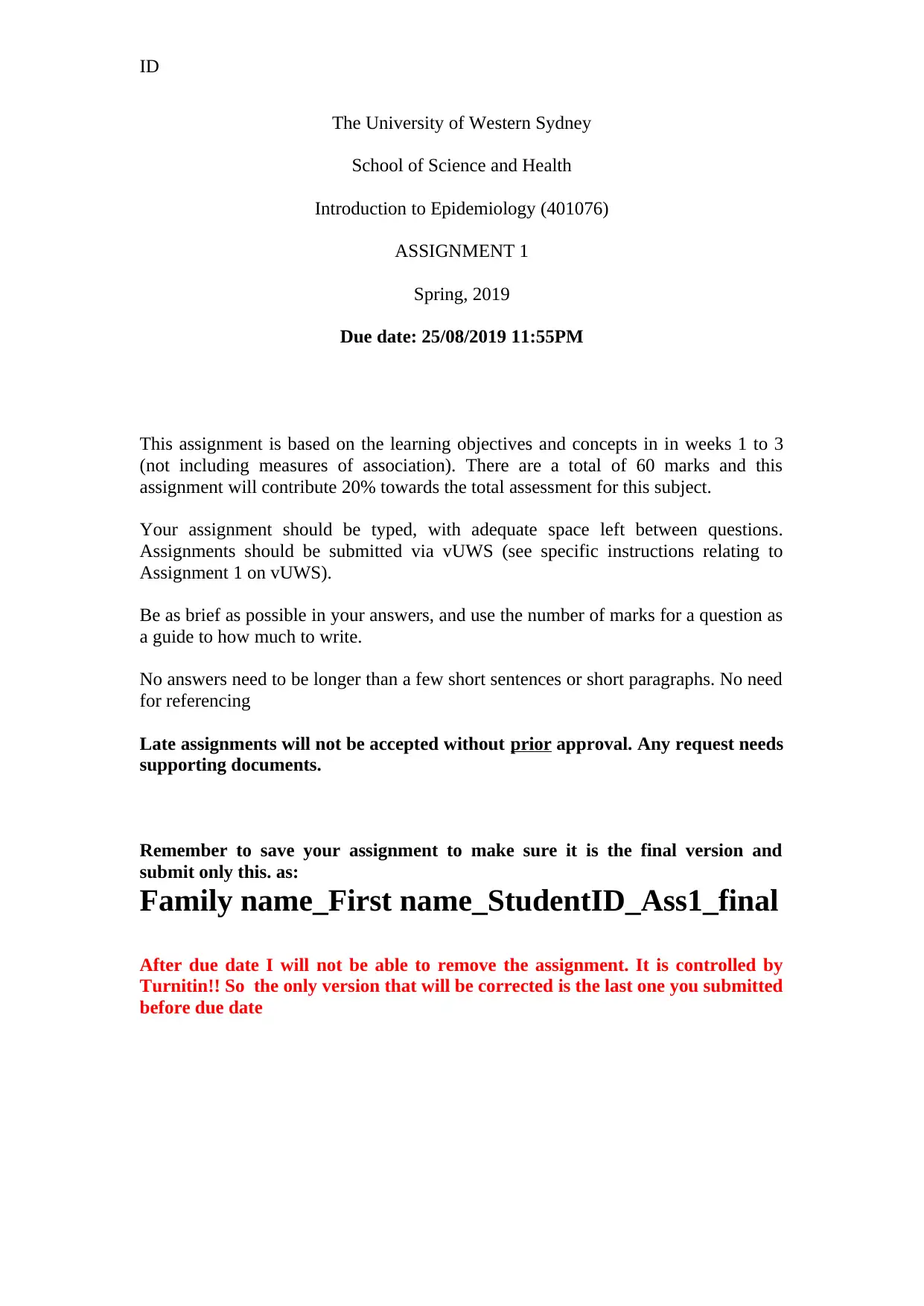
ID
The University of Western Sydney
School of Science and Health
Introduction to Epidemiology (401076)
ASSIGNMENT 1
Spring, 2019
Due date: 25/08/2019 11:55PM
This assignment is based on the learning objectives and concepts in in weeks 1 to 3
(not including measures of association). There are a total of 60 marks and this
assignment will contribute 20% towards the total assessment for this subject.
Your assignment should be typed, with adequate space left between questions.
Assignments should be submitted via vUWS (see specific instructions relating to
Assignment 1 on vUWS).
Be as brief as possible in your answers, and use the number of marks for a question as
a guide to how much to write.
No answers need to be longer than a few short sentences or short paragraphs. No need
for referencing
Late assignments will not be accepted without prior approval. Any request needs
supporting documents.
Remember to save your assignment to make sure it is the final version and
submit only this. as:
Family name_First name_StudentID_Ass1_final
After due date I will not be able to remove the assignment. It is controlled by
Turnitin!! So the only version that will be corrected is the last one you submitted
before due date
The University of Western Sydney
School of Science and Health
Introduction to Epidemiology (401076)
ASSIGNMENT 1
Spring, 2019
Due date: 25/08/2019 11:55PM
This assignment is based on the learning objectives and concepts in in weeks 1 to 3
(not including measures of association). There are a total of 60 marks and this
assignment will contribute 20% towards the total assessment for this subject.
Your assignment should be typed, with adequate space left between questions.
Assignments should be submitted via vUWS (see specific instructions relating to
Assignment 1 on vUWS).
Be as brief as possible in your answers, and use the number of marks for a question as
a guide to how much to write.
No answers need to be longer than a few short sentences or short paragraphs. No need
for referencing
Late assignments will not be accepted without prior approval. Any request needs
supporting documents.
Remember to save your assignment to make sure it is the final version and
submit only this. as:
Family name_First name_StudentID_Ass1_final
After due date I will not be able to remove the assignment. It is controlled by
Turnitin!! So the only version that will be corrected is the last one you submitted
before due date
Paraphrase This Document
Need a fresh take? Get an instant paraphrase of this document with our AI Paraphraser
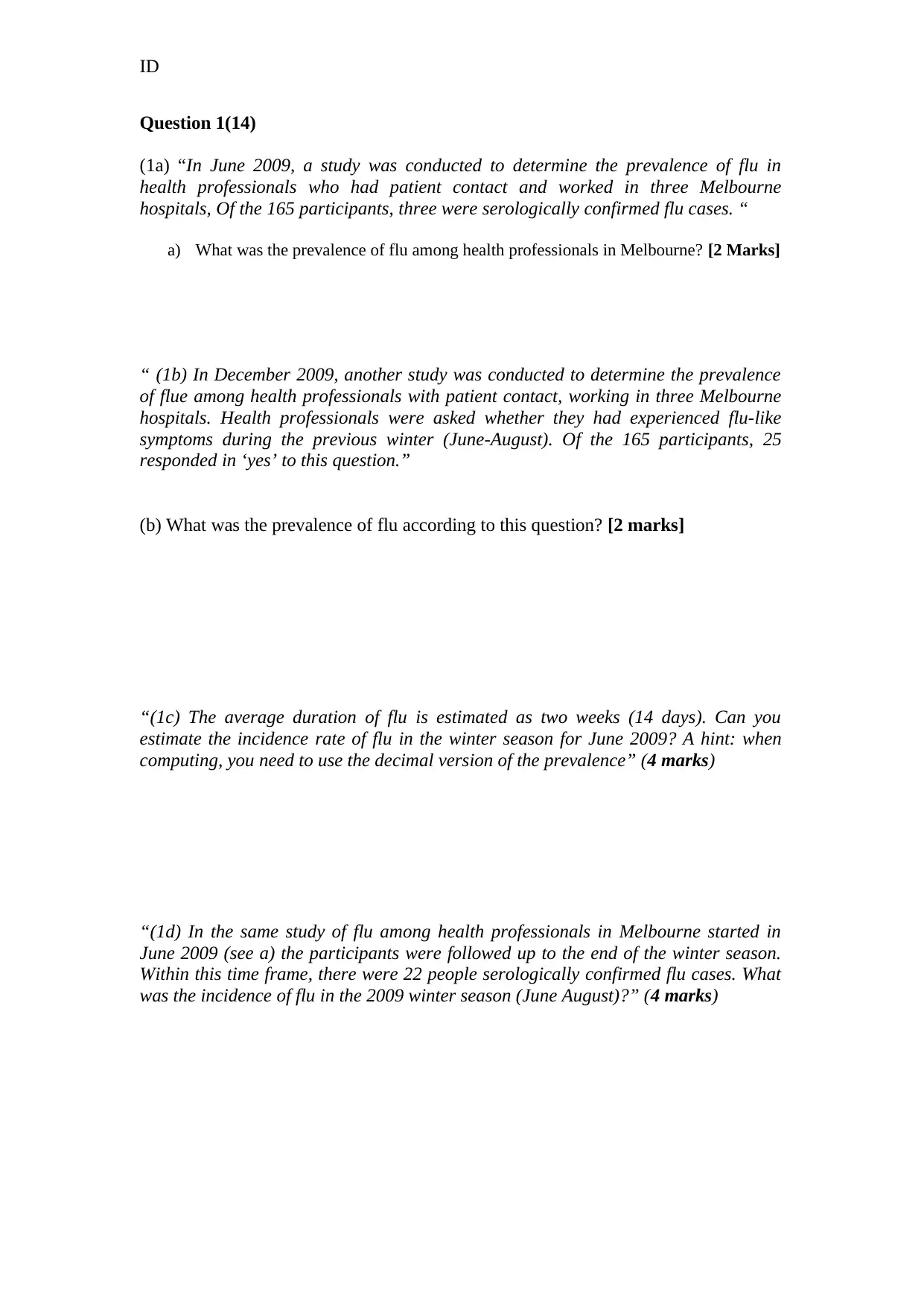
ID
Question 1(14)
(1a) “In June 2009, a study was conducted to determine the prevalence of flu in
health professionals who had patient contact and worked in three Melbourne
hospitals, Of the 165 participants, three were serologically confirmed flu cases. “
a) What was the prevalence of flu among health professionals in Melbourne? [2 Marks]
“ (1b) In December 2009, another study was conducted to determine the prevalence
of flue among health professionals with patient contact, working in three Melbourne
hospitals. Health professionals were asked whether they had experienced flu-like
symptoms during the previous winter (June-August). Of the 165 participants, 25
responded in ‘yes’ to this question.”
(b) What was the prevalence of flu according to this question? [2 marks]
“(1c) The average duration of flu is estimated as two weeks (14 days). Can you
estimate the incidence rate of flu in the winter season for June 2009? A hint: when
computing, you need to use the decimal version of the prevalence” (4 marks)
“(1d) In the same study of flu among health professionals in Melbourne started in
June 2009 (see a) the participants were followed up to the end of the winter season.
Within this time frame, there were 22 people serologically confirmed flu cases. What
was the incidence of flu in the 2009 winter season (June August)?” (4 marks)
Question 1(14)
(1a) “In June 2009, a study was conducted to determine the prevalence of flu in
health professionals who had patient contact and worked in three Melbourne
hospitals, Of the 165 participants, three were serologically confirmed flu cases. “
a) What was the prevalence of flu among health professionals in Melbourne? [2 Marks]
“ (1b) In December 2009, another study was conducted to determine the prevalence
of flue among health professionals with patient contact, working in three Melbourne
hospitals. Health professionals were asked whether they had experienced flu-like
symptoms during the previous winter (June-August). Of the 165 participants, 25
responded in ‘yes’ to this question.”
(b) What was the prevalence of flu according to this question? [2 marks]
“(1c) The average duration of flu is estimated as two weeks (14 days). Can you
estimate the incidence rate of flu in the winter season for June 2009? A hint: when
computing, you need to use the decimal version of the prevalence” (4 marks)
“(1d) In the same study of flu among health professionals in Melbourne started in
June 2009 (see a) the participants were followed up to the end of the winter season.
Within this time frame, there were 22 people serologically confirmed flu cases. What
was the incidence of flu in the 2009 winter season (June August)?” (4 marks)
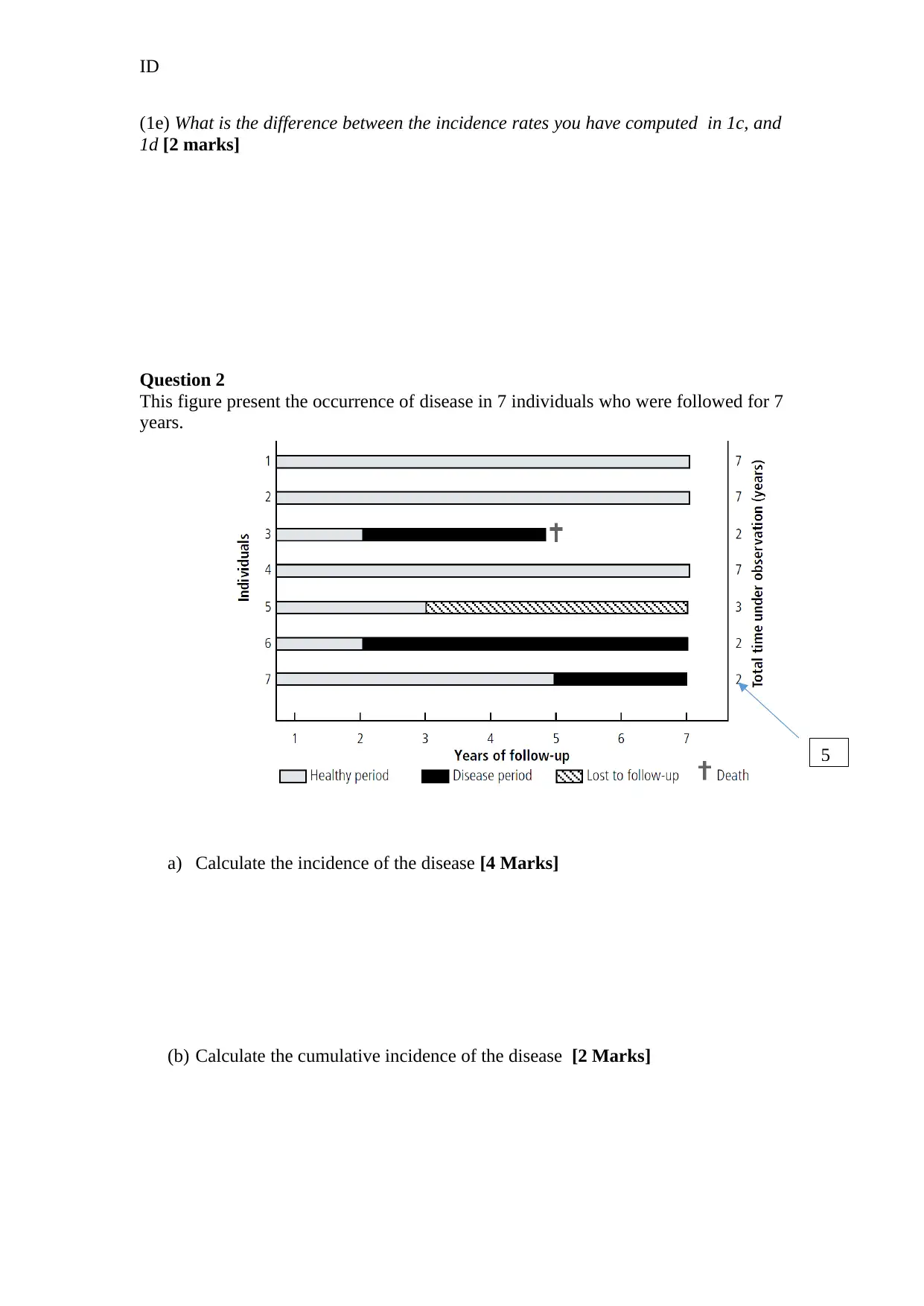
ID
(1e) What is the difference between the incidence rates you have computed in 1c, and
1d [2 marks]
Question 2
This figure present the occurrence of disease in 7 individuals who were followed for 7
years.
a) Calculate the incidence of the disease [4 Marks]
(b) Calculate the cumulative incidence of the disease [2 Marks]
5
(1e) What is the difference between the incidence rates you have computed in 1c, and
1d [2 marks]
Question 2
This figure present the occurrence of disease in 7 individuals who were followed for 7
years.
a) Calculate the incidence of the disease [4 Marks]
(b) Calculate the cumulative incidence of the disease [2 Marks]
5
⊘ This is a preview!⊘
Do you want full access?
Subscribe today to unlock all pages.

Trusted by 1+ million students worldwide
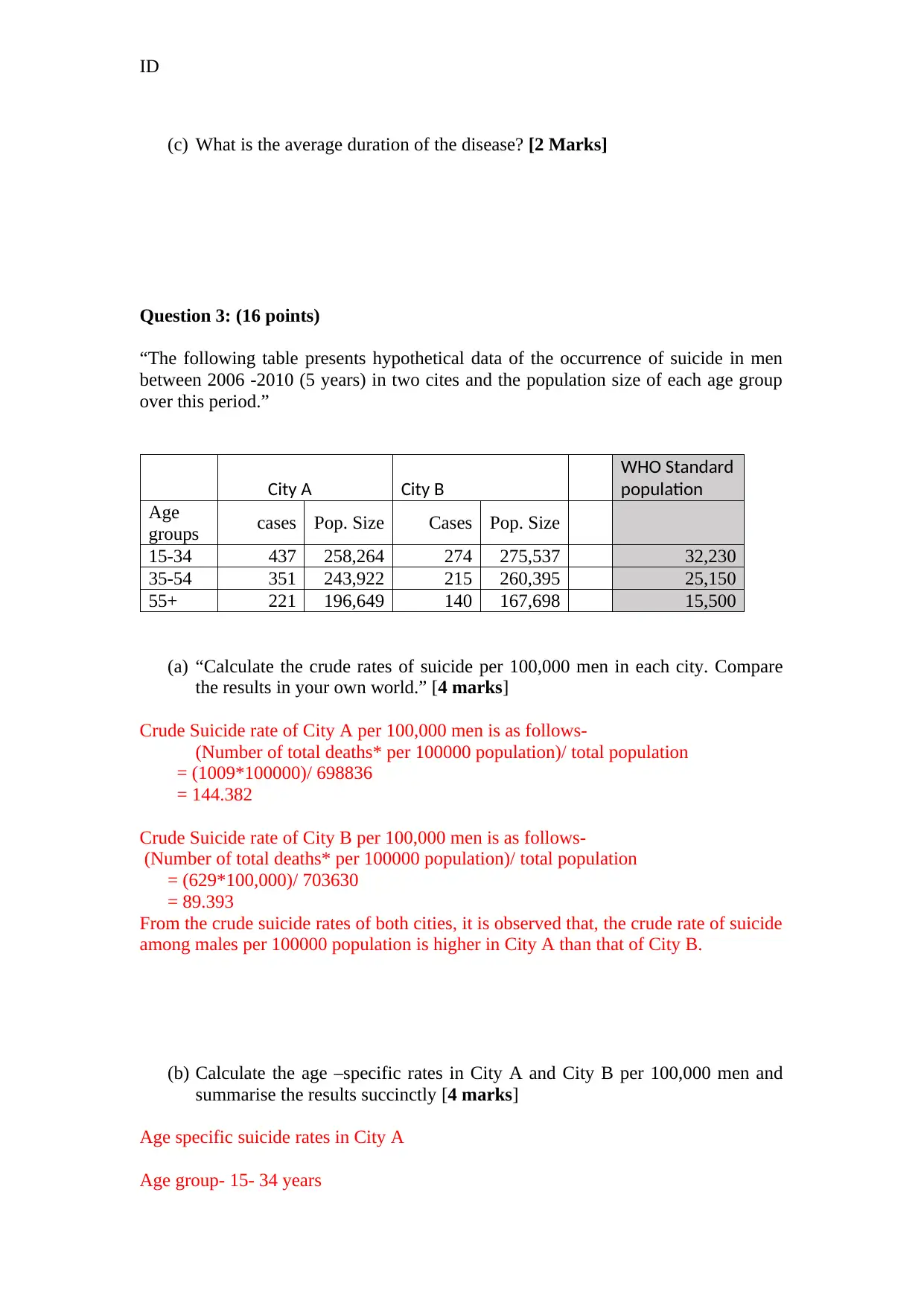
ID
(c) What is the average duration of the disease? [2 Marks]
Question 3: (16 points)
“The following table presents hypothetical data of the occurrence of suicide in men
between 2006 -2010 (5 years) in two cites and the population size of each age group
over this period.”
City A City B
WHO Standard
population
Age
groups cases Pop. Size Cases Pop. Size
15-34 437 258,264 274 275,537 32,230
35-54 351 243,922 215 260,395 25,150
55+ 221 196,649 140 167,698 15,500
(a) “Calculate the crude rates of suicide per 100,000 men in each city. Compare
the results in your own world.” [4 marks]
Crude Suicide rate of City A per 100,000 men is as follows-
(Number of total deaths* per 100000 population)/ total population
= (1009*100000)/ 698836
= 144.382
Crude Suicide rate of City B per 100,000 men is as follows-
(Number of total deaths* per 100000 population)/ total population
= (629*100,000)/ 703630
= 89.393
From the crude suicide rates of both cities, it is observed that, the crude rate of suicide
among males per 100000 population is higher in City A than that of City B.
(b) Calculate the age –specific rates in City A and City B per 100,000 men and
summarise the results succinctly [4 marks]
Age specific suicide rates in City A
Age group- 15- 34 years
(c) What is the average duration of the disease? [2 Marks]
Question 3: (16 points)
“The following table presents hypothetical data of the occurrence of suicide in men
between 2006 -2010 (5 years) in two cites and the population size of each age group
over this period.”
City A City B
WHO Standard
population
Age
groups cases Pop. Size Cases Pop. Size
15-34 437 258,264 274 275,537 32,230
35-54 351 243,922 215 260,395 25,150
55+ 221 196,649 140 167,698 15,500
(a) “Calculate the crude rates of suicide per 100,000 men in each city. Compare
the results in your own world.” [4 marks]
Crude Suicide rate of City A per 100,000 men is as follows-
(Number of total deaths* per 100000 population)/ total population
= (1009*100000)/ 698836
= 144.382
Crude Suicide rate of City B per 100,000 men is as follows-
(Number of total deaths* per 100000 population)/ total population
= (629*100,000)/ 703630
= 89.393
From the crude suicide rates of both cities, it is observed that, the crude rate of suicide
among males per 100000 population is higher in City A than that of City B.
(b) Calculate the age –specific rates in City A and City B per 100,000 men and
summarise the results succinctly [4 marks]
Age specific suicide rates in City A
Age group- 15- 34 years
Paraphrase This Document
Need a fresh take? Get an instant paraphrase of this document with our AI Paraphraser
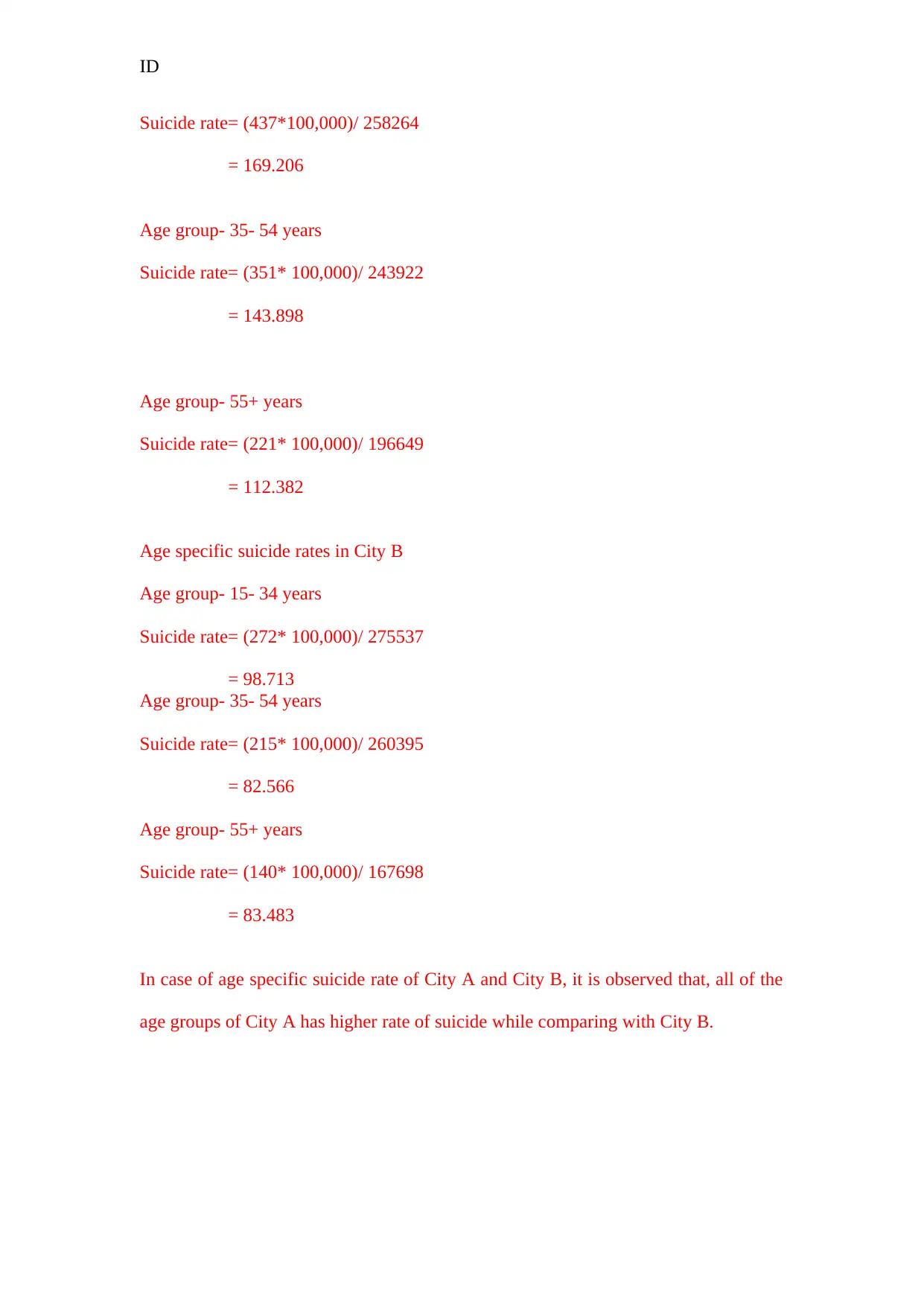
ID
Suicide rate= (437*100,000)/ 258264
= 169.206
Age group- 35- 54 years
Suicide rate= (351* 100,000)/ 243922
= 143.898
Age group- 55+ years
Suicide rate= (221* 100,000)/ 196649
= 112.382
Age specific suicide rates in City B
Age group- 15- 34 years
Suicide rate= (272* 100,000)/ 275537
= 98.713
Age group- 35- 54 years
Suicide rate= (215* 100,000)/ 260395
= 82.566
Age group- 55+ years
Suicide rate= (140* 100,000)/ 167698
= 83.483
In case of age specific suicide rate of City A and City B, it is observed that, all of the
age groups of City A has higher rate of suicide while comparing with City B.
Suicide rate= (437*100,000)/ 258264
= 169.206
Age group- 35- 54 years
Suicide rate= (351* 100,000)/ 243922
= 143.898
Age group- 55+ years
Suicide rate= (221* 100,000)/ 196649
= 112.382
Age specific suicide rates in City B
Age group- 15- 34 years
Suicide rate= (272* 100,000)/ 275537
= 98.713
Age group- 35- 54 years
Suicide rate= (215* 100,000)/ 260395
= 82.566
Age group- 55+ years
Suicide rate= (140* 100,000)/ 167698
= 83.483
In case of age specific suicide rate of City A and City B, it is observed that, all of the
age groups of City A has higher rate of suicide while comparing with City B.
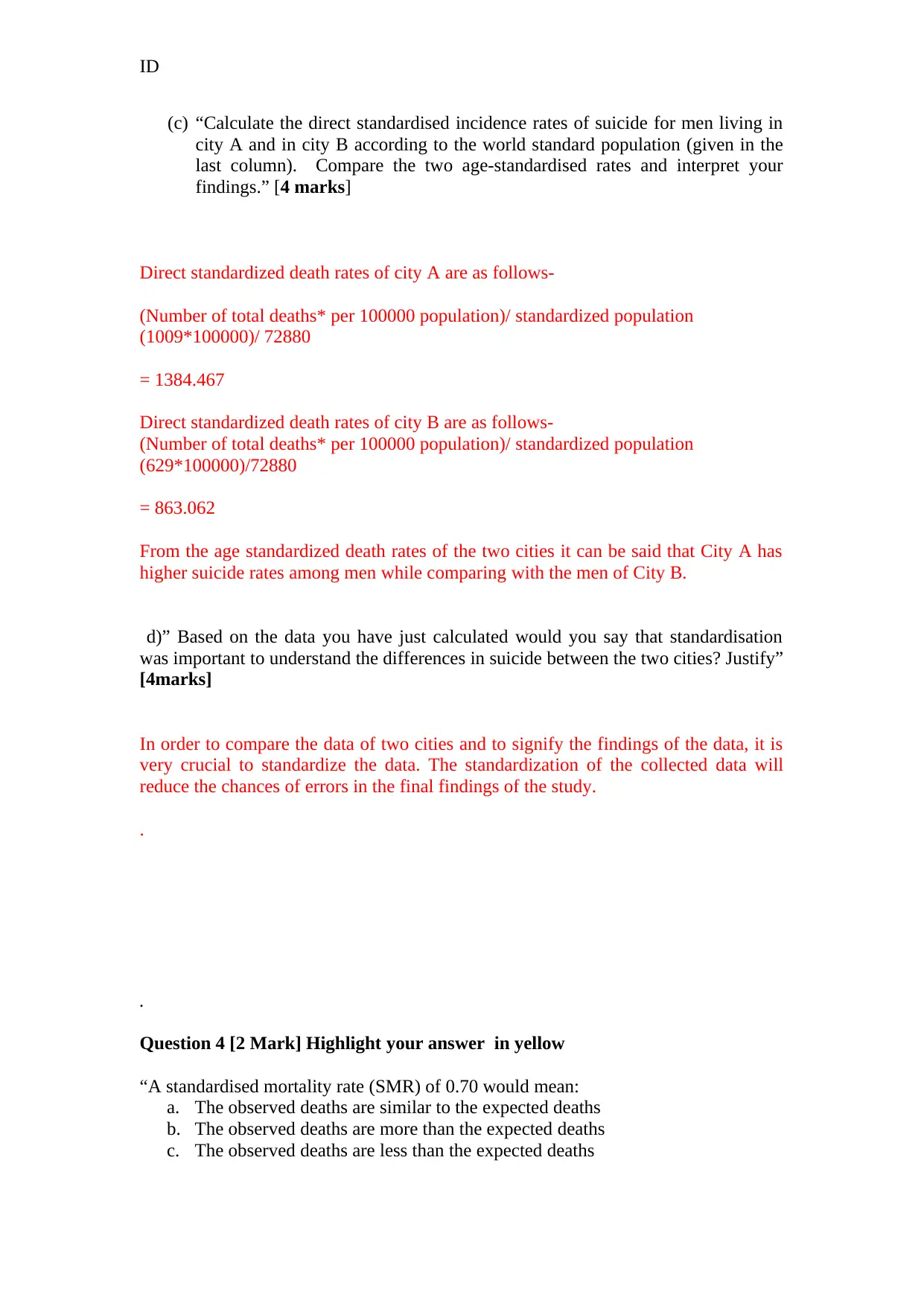
ID
(c) “Calculate the direct standardised incidence rates of suicide for men living in
city A and in city B according to the world standard population (given in the
last column). Compare the two age-standardised rates and interpret your
findings.” [4 marks]
Direct standardized death rates of city A are as follows-
(Number of total deaths* per 100000 population)/ standardized population
(1009*100000)/ 72880
= 1384.467
Direct standardized death rates of city B are as follows-
(Number of total deaths* per 100000 population)/ standardized population
(629*100000)/72880
= 863.062
From the age standardized death rates of the two cities it can be said that City A has
higher suicide rates among men while comparing with the men of City B.
d)” Based on the data you have just calculated would you say that standardisation
was important to understand the differences in suicide between the two cities? Justify”
[4marks]
In order to compare the data of two cities and to signify the findings of the data, it is
very crucial to standardize the data. The standardization of the collected data will
reduce the chances of errors in the final findings of the study.
.
.
Question 4 [2 Mark] Highlight your answer in yellow
“A standardised mortality rate (SMR) of 0.70 would mean:
a. The observed deaths are similar to the expected deaths
b. The observed deaths are more than the expected deaths
c. The observed deaths are less than the expected deaths
(c) “Calculate the direct standardised incidence rates of suicide for men living in
city A and in city B according to the world standard population (given in the
last column). Compare the two age-standardised rates and interpret your
findings.” [4 marks]
Direct standardized death rates of city A are as follows-
(Number of total deaths* per 100000 population)/ standardized population
(1009*100000)/ 72880
= 1384.467
Direct standardized death rates of city B are as follows-
(Number of total deaths* per 100000 population)/ standardized population
(629*100000)/72880
= 863.062
From the age standardized death rates of the two cities it can be said that City A has
higher suicide rates among men while comparing with the men of City B.
d)” Based on the data you have just calculated would you say that standardisation
was important to understand the differences in suicide between the two cities? Justify”
[4marks]
In order to compare the data of two cities and to signify the findings of the data, it is
very crucial to standardize the data. The standardization of the collected data will
reduce the chances of errors in the final findings of the study.
.
.
Question 4 [2 Mark] Highlight your answer in yellow
“A standardised mortality rate (SMR) of 0.70 would mean:
a. The observed deaths are similar to the expected deaths
b. The observed deaths are more than the expected deaths
c. The observed deaths are less than the expected deaths
⊘ This is a preview!⊘
Do you want full access?
Subscribe today to unlock all pages.

Trusted by 1+ million students worldwide
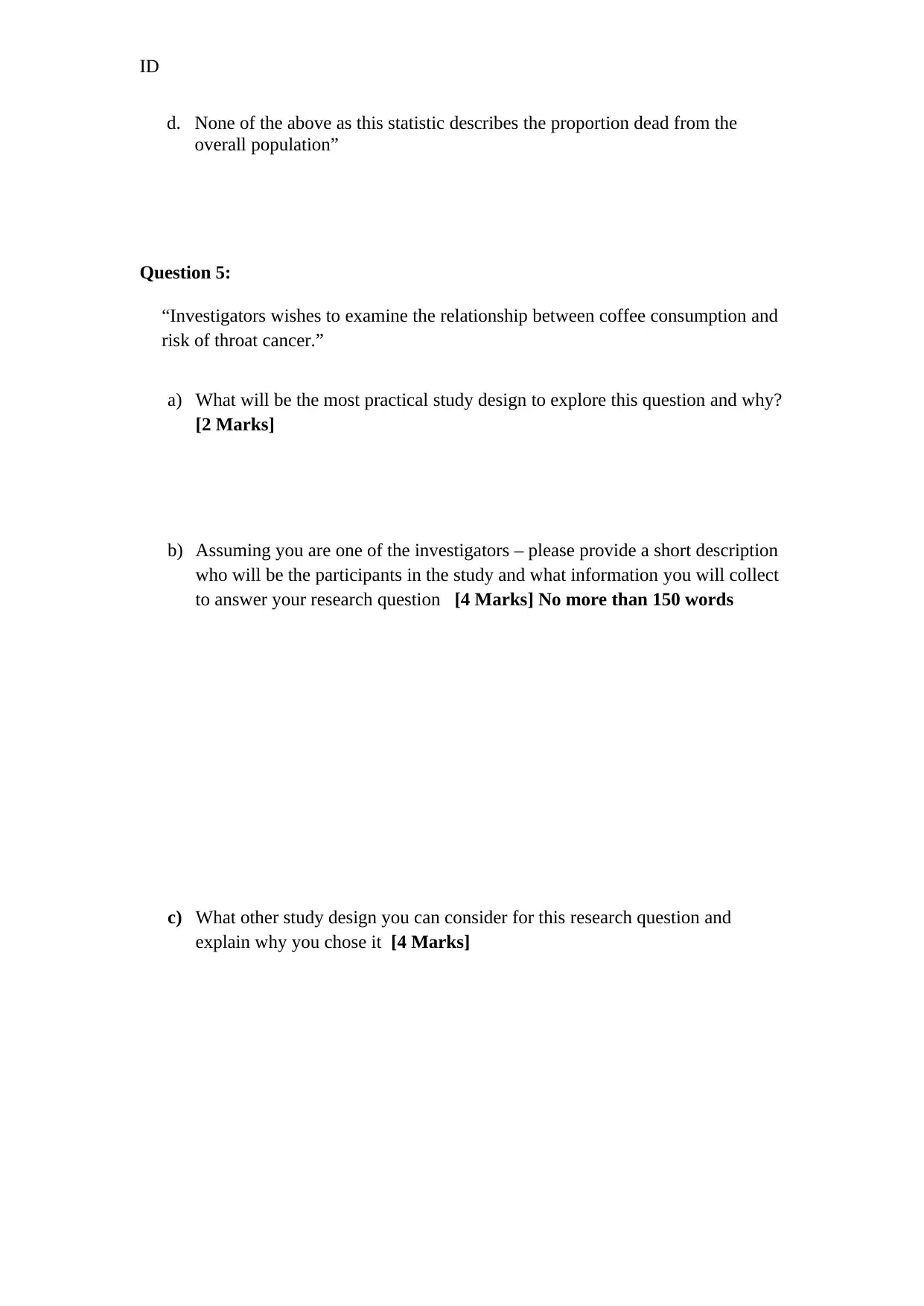
ID
d. None of the above as this statistic describes the proportion dead from the
overall population”
Question 5:
“Investigators wishes to examine the relationship between coffee consumption and
risk of throat cancer.”
a) What will be the most practical study design to explore this question and why?
[2 Marks]
b) Assuming you are one of the investigators – please provide a short description
who will be the participants in the study and what information you will collect
to answer your research question [4 Marks] No more than 150 words
c) What other study design you can consider for this research question and
explain why you chose it [4 Marks]
d. None of the above as this statistic describes the proportion dead from the
overall population”
Question 5:
“Investigators wishes to examine the relationship between coffee consumption and
risk of throat cancer.”
a) What will be the most practical study design to explore this question and why?
[2 Marks]
b) Assuming you are one of the investigators – please provide a short description
who will be the participants in the study and what information you will collect
to answer your research question [4 Marks] No more than 150 words
c) What other study design you can consider for this research question and
explain why you chose it [4 Marks]
Paraphrase This Document
Need a fresh take? Get an instant paraphrase of this document with our AI Paraphraser
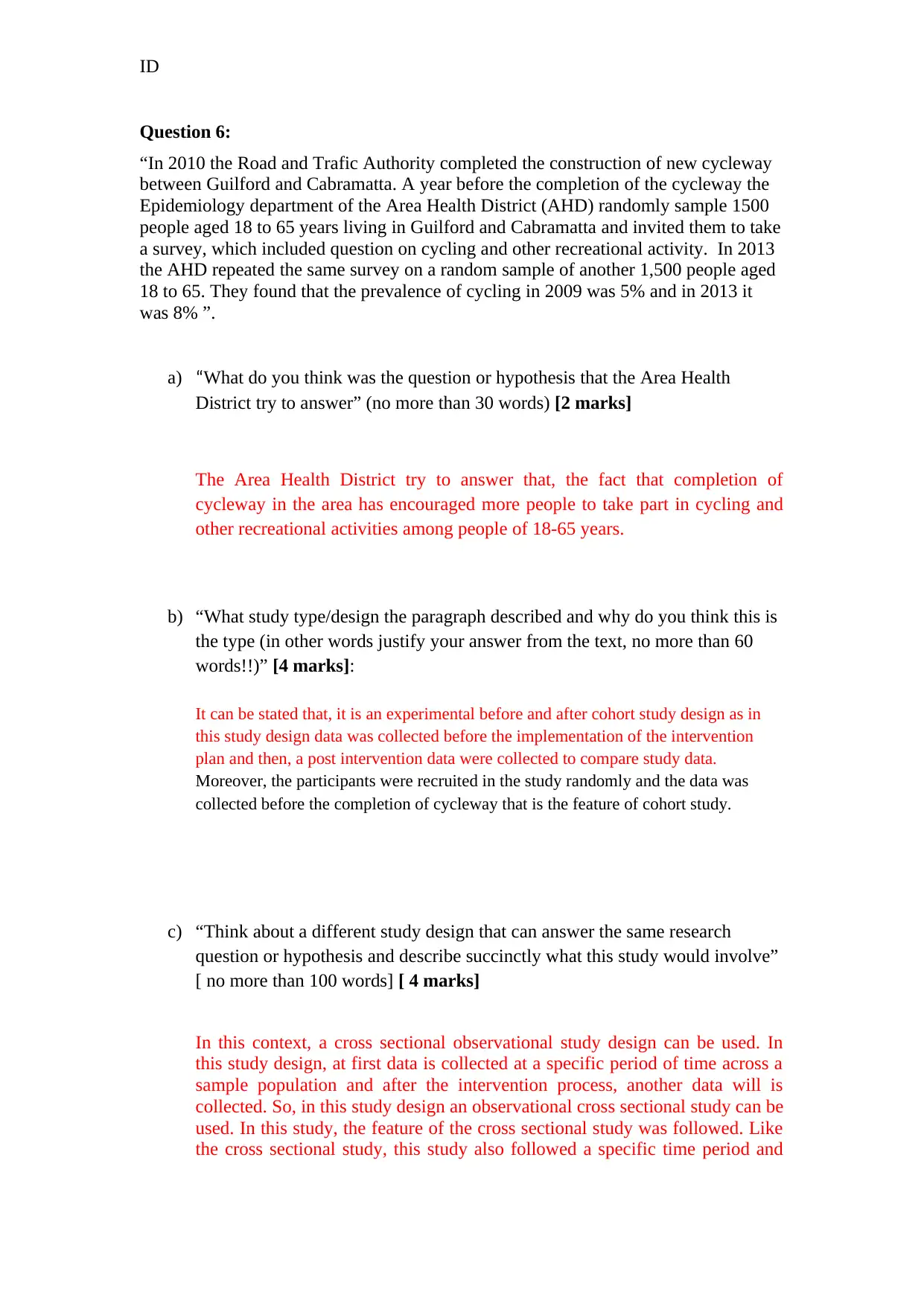
ID
Question 6:
“In 2010 the Road and Trafic Authority completed the construction of new cycleway
between Guilford and Cabramatta. A year before the completion of the cycleway the
Epidemiology department of the Area Health District (AHD) randomly sample 1500
people aged 18 to 65 years living in Guilford and Cabramatta and invited them to take
a survey, which included question on cycling and other recreational activity. In 2013
the AHD repeated the same survey on a random sample of another 1,500 people aged
18 to 65. They found that the prevalence of cycling in 2009 was 5% and in 2013 it
was 8% ”.
a) “What do you think was the question or hypothesis that the Area Health
District try to answer” (no more than 30 words) [2 marks]
The Area Health District try to answer that, the fact that completion of
cycleway in the area has encouraged more people to take part in cycling and
other recreational activities among people of 18-65 years.
b) “What study type/design the paragraph described and why do you think this is
the type (in other words justify your answer from the text, no more than 60
words!!)” [4 marks]:
It can be stated that, it is an experimental before and after cohort study design as in
this study design data was collected before the implementation of the intervention
plan and then, a post intervention data were collected to compare study data.
Moreover, the participants were recruited in the study randomly and the data was
collected before the completion of cycleway that is the feature of cohort study.
c) “Think about a different study design that can answer the same research
question or hypothesis and describe succinctly what this study would involve”
[ no more than 100 words] [ 4 marks]
In this context, a cross sectional observational study design can be used. In
this study design, at first data is collected at a specific period of time across a
sample population and after the intervention process, another data will is
collected. So, in this study design an observational cross sectional study can be
used. In this study, the feature of the cross sectional study was followed. Like
the cross sectional study, this study also followed a specific time period and
Question 6:
“In 2010 the Road and Trafic Authority completed the construction of new cycleway
between Guilford and Cabramatta. A year before the completion of the cycleway the
Epidemiology department of the Area Health District (AHD) randomly sample 1500
people aged 18 to 65 years living in Guilford and Cabramatta and invited them to take
a survey, which included question on cycling and other recreational activity. In 2013
the AHD repeated the same survey on a random sample of another 1,500 people aged
18 to 65. They found that the prevalence of cycling in 2009 was 5% and in 2013 it
was 8% ”.
a) “What do you think was the question or hypothesis that the Area Health
District try to answer” (no more than 30 words) [2 marks]
The Area Health District try to answer that, the fact that completion of
cycleway in the area has encouraged more people to take part in cycling and
other recreational activities among people of 18-65 years.
b) “What study type/design the paragraph described and why do you think this is
the type (in other words justify your answer from the text, no more than 60
words!!)” [4 marks]:
It can be stated that, it is an experimental before and after cohort study design as in
this study design data was collected before the implementation of the intervention
plan and then, a post intervention data were collected to compare study data.
Moreover, the participants were recruited in the study randomly and the data was
collected before the completion of cycleway that is the feature of cohort study.
c) “Think about a different study design that can answer the same research
question or hypothesis and describe succinctly what this study would involve”
[ no more than 100 words] [ 4 marks]
In this context, a cross sectional observational study design can be used. In
this study design, at first data is collected at a specific period of time across a
sample population and after the intervention process, another data will is
collected. So, in this study design an observational cross sectional study can be
used. In this study, the feature of the cross sectional study was followed. Like
the cross sectional study, this study also followed a specific time period and

ID
the sample population was same. Before and after the intervention, the
observation data was collected.
the sample population was same. Before and after the intervention, the
observation data was collected.
⊘ This is a preview!⊘
Do you want full access?
Subscribe today to unlock all pages.

Trusted by 1+ million students worldwide
1 out of 9
Your All-in-One AI-Powered Toolkit for Academic Success.
+13062052269
info@desklib.com
Available 24*7 on WhatsApp / Email
![[object Object]](/_next/static/media/star-bottom.7253800d.svg)
Unlock your academic potential
Copyright © 2020–2025 A2Z Services. All Rights Reserved. Developed and managed by ZUCOL.

